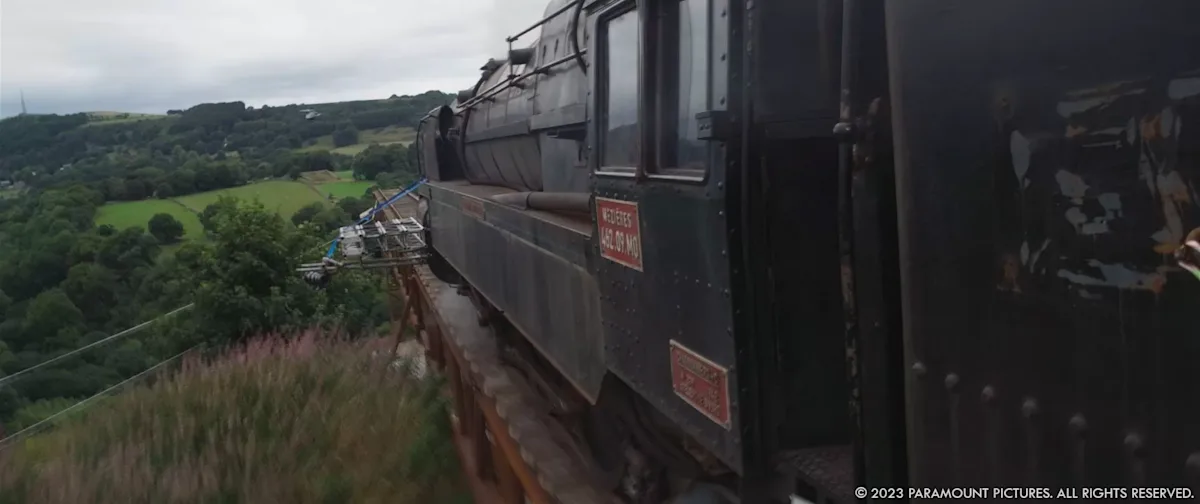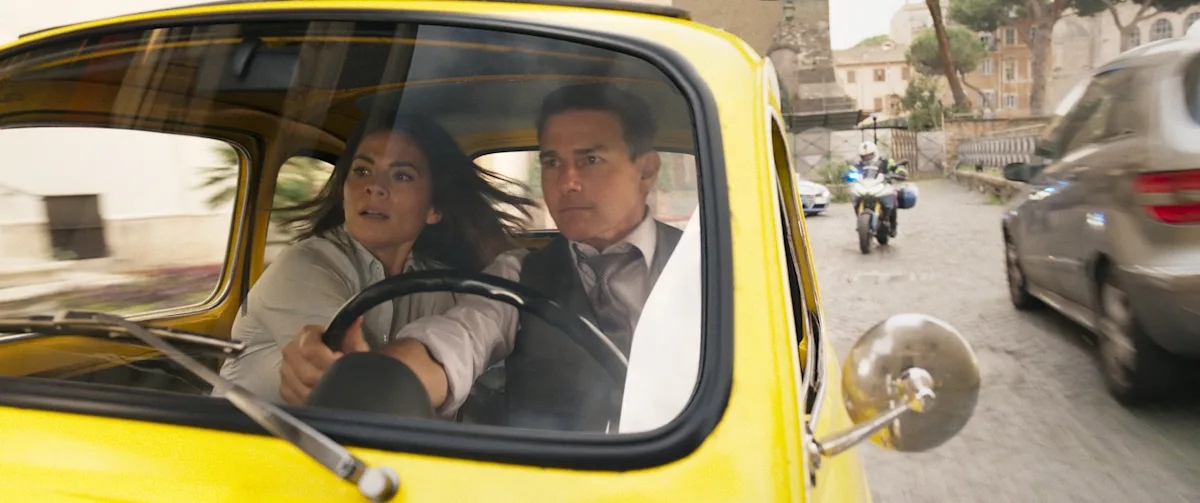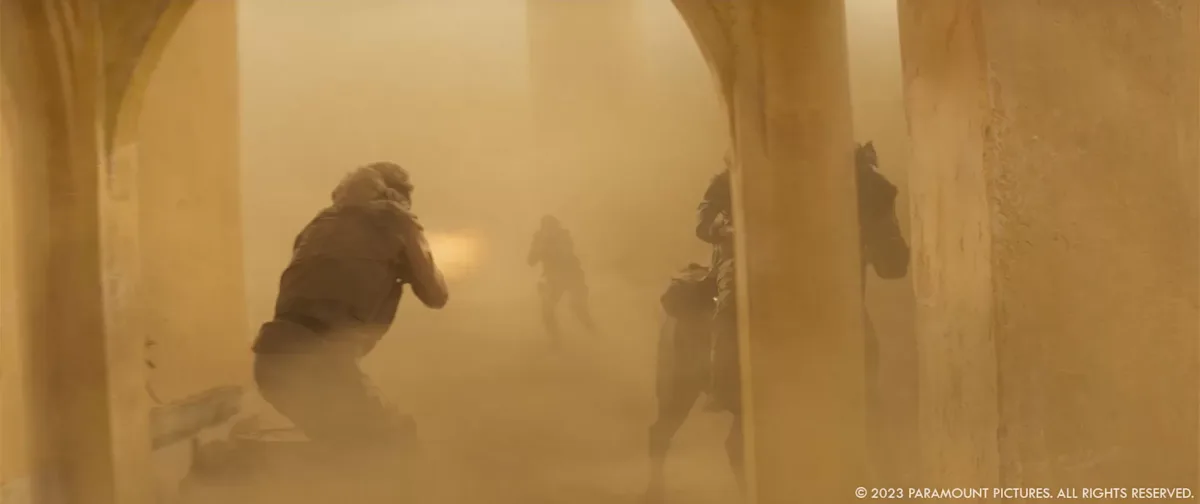Leave it to Mission: Impossible to defy the odds: After nearly 30 years, the seventh movie in the series — Mission: Impossible - Dead Reckoning Part One — earned the franchise's first Oscar nominations. At the 96th Oscars, Dead Reckoning Part One is up for two awards: Best Sound and Best Visual Effects.
Dead Reckoning promised to be Ethan Hunt's "most dangerous mission yet," and Tom Cruise more than delivered with a car chase in Rome, a gunfight in the Arabian Desert, and a brawl atop a speeding train. As he is wont to do, Cruise performed all of his own stunts, while the visual effects team who was tasked with making even the most improbable set pieces feel thrillingly real.
"It's a gradual process of belief building and an almost religious process of having faith in what we can do," explains Visual Effects Supervisor Alex Wuttke. "When you build that, it opens doors, and all of a sudden, new things are possible. We can shoot things in ways that mean we don't have to go around the houses to achieve something."
The Oscar nomination recognizes Visual Effects Supervisors Wuttke, Simone Coco and Jeff Sutherland and Special Effects Supervisor Neil Corbould, although they are the first to acknowledge that the movie would not have been possible without the work of countless artists and numerous VFX vendors. (Of note, Coco is a double nominee this year, also recognized for his work on Napoleon, and Corbould is a triple nominee for Dead Reckoning Part One, The Creator and Napoleon.)
Here, the team explains why nothing was impossible when it came to Dead Reckoning Part One.
A.frame: What was the total number of VFX shots in this? And how does that compare to other Mission: Impossible movies?
Alex Wuttke: I think the final shot count was around 3,700, which is a vast amount of work. Most movies are in the 1,200 to 1,400 shot zone. Part of the reason there were so many in Dead Reckoning is because we were working for so long, shooting for over three years, and accruing so much footage, all of which was spectacular. If you were to go with the original assembly, it would have made a four-and-a-half-hour movie. Because we were shooting for so long and the edit was open for such an extended amount of time, it behooved us to keep going, so we carried that for quite a long way into post. Towards the end, we whittled it down to about 2,500.

When there is such a vast amount of work, were you given specific sequences to work on? How was that organized, and where did you start?
Neil Corbould: From me, it was the practical side of things, so reading through the script, we started with certain set pieces. We knew that we were doing the train very early on and would do a Fiat 500 chase sequence in Rome, so it was about breaking them down to see how they evolved. For instance, with the train, McQ just said, 'I want to do a train crash on this one, and I want it to be a steam train.' Obviously, you can't buy a steam train, so I said, 'Okay, we'll have to make it.' Then it was, 'Well, I want it to crash off a bridge.' It just went on from there. The Fiat 500 sequence was a similar thing. He said, 'We want to do a car chase. Wouldn't it be funny if we did it with a Fiat 500?' I told him they were not very reliable, but we could change the engine in it, so we changed it for a 500-horsepower electric vehicle engine, and the Fiat became a different beast. It almost became a character of the movie in its own right.
Wuttke: I came on early as the overall supervisor and also had those early conversations with Chris. We talked a lot about the different sequences that he had in mind and ways of staging action. We talked a lot about other things I've done in the past, such as a couple of Bond movies. He was keen to hear about those, because the way the action is approached in those movies is relevant to how he wanted to do it in Dead Reckoning. The twist with Mission: Impossible is that Tom does his stunts, so he's always front and center, which dictates much of the film's language and the way we shoot things. It's very much, 'Tom's going to be in the heart of the action, so let's put the camera up there as well.' From there, we started getting into the specifics of each sequence, and once we had a handle on that, we could begin to bring Jeff and Simone into the process, and they covered the lion's share of the movie between them.
Jeff and Simone, what did that look like for you?
Jeff Sutherland: It was a large volume of work to get through, and the main facilities working on it were our London facility and our Sydney facility, which was brand new at the time. As a general rule, Simone was looking after the Sydney crew, and I was looking after the London crew, then specific significant beats of the movie were split between those two facilities.
Simone Coco: The Sydney team worked on most of the train sequence, the tunnel, and the destruction on the bridge. We worked on that and the set extension, too, and then we did some work on the big jump sequence for Tom. From all the behind-the-scenes effects footage, you can see that it was a massive chunk of work, so it needed to be split up.


Christopher McQuarrie is quite skeptical of effects, despite the Mission: Impossible movies incorporating so many of them. How did you find the right balance?
Wuttke: The whole process was an interesting evolution. In the early production meetings, Neil and I talked about putting the train on tracks and wondered how we would do the pistons. Could we do that practically? And it's like, 'Yeah, but it's very expensive. It might be better for Alex to do it.' Initially, we were saying, 'No, he'll never believe it,' and then cut to the end of the project, and Tom Cruise is the only real thing in the shot. It's a gradual process of building faith in what we can do. It starts off with very small things. In the early days, it was about stuff like roto, because Chris had experiences in the past where he didn't think it could be done correctly. But we gave him some results that showed him what it looked like when it was done right, and he was on board. When you build that [trust], it opens doors, and all of a sudden, new things are possible. We can shoot things in ways that mean we don't have to go around the houses to achieve something.
Many people assume that VFX involves adding things that weren't there, but a lot of the effects work here involved removing or replacing elements. I believe some of the motorcycle sequence was shown in the studio parking lot.
Sutherland: That's very true. The Fiat car chase in Rome is a great example, too. There were some primary vehicles involved in that, and very often, there was either camera gear in the shots or maybe three cameras mounted on the cars, so a lot of time, it was a case of doing digital versions of the vehicles to help remove those. The motorcycle shot in a parking lot was a pickup long after the fact back in the U.K. That's a wholly digital environment shot, using the survey material and everything Alex brought back from Norway to recreate the terrain and seamlessly put that in. It makes each sequence and each shot its own puzzle to solve, because it has particular requirements and needs.

The team used a lot of green screens rather than a Volume, which is becoming more commonly used in movies like this. Why was that?
Coco: That call ultimately comes from the filmmaker, because they prefer to shoot for real as much as possible. The Volume is not huge, so you need to be quite contained, and you can't put a massive gimbal in that and try to shoot in there, but you can with a green screen.
Wuttke: For example, the original intent with the carriage interiors was that we were looking at doing a pop-up Volume for all of the backgrounds outside the windows, principally because there's so much shiny stuff on the interior of that carriage. There are so many reflections and things like that that it was a natural choice. However, at some point, the decision was made to go from one carriage to three carriages all joined together on the stage. We filled the entirety of one of the big stages at Leavesden so that they could film continuous runs of action through them, and the cost of surrounding that with a Volume would've been financially prohibitive at that point.
Another big set piece in the movie is the sandstorm scene, which goes from beautiful wide shots to very close and claustrophobic action with many challenging conditions, like a sandstorm. How much of that was in camera, and how much was added afterward?
Wuttke: Neil, you'll probably want to talk about your jet engine at this point. [Laughs]
Corbould: McQ said he wanted to do this sandstorm and asked, 'Have you got any big wind machines?' It happened that I had this jet engine, so he said, 'I want to use that.' We showed him some tests we did, which gave such a powerful volume of wind. There are no petrol-driven wind machines that can create that amount of air. It gives you the force of the wind for the rest of the sequence. We have conventional wind machines there, but the jet engine was the primary source, and he liked the look of it. It actually ruined my jet engine, because it was sucking sand in at the back and it was sandblasting the impeller of the jet. It wasn't a lot of good at the end, but we got the shot!
Wuttke: And it makes for this incredibly visceral context you're putting your actors into. It's a really violent environment. Everyone was in goggles and protective equipment, and it set the tone for the sequence. Going back from wide to tight with the shots was a very conscious decision by McQ, who wanted to start things off with these beautiful Lawrence of Arabia-style vistas and get this idea of this tiny figure in this vast landscape. Still, as you close in on the action, the frames get tighter and tighter, and you're right inside Ethan's eye line, which was a very conscious decision. The sandstorm was a vehicle for driving that focus in.
Sutherland: Some of the shots that Neil was talking about, using his jet engine and whipping the sand around, there were a couple of shots that were really beautiful, that were almost like up-angle shots looking into the sun. You had the sun burning through the blowing sand, and those fully practical shots became a touchstone for us when we were putting together the sequence and adding digital blowing sand elements. We used those shots to really key off. They gave some excellent visibility but also made the shots dramatic, giving them a nice aesthetic to follow as a guide throughout the sequence.


It wouldn't be a Mission: Impossible movie without a mask reveal. How is what you did with this one different from previous films, due to the technology available?
Wuttke: With these sorts of things, where it's a pretty complex sleight of hand with multiple elements, you're usually doing it with a locked-off camera, or you're doing motion control, which brings its own slowness to how you shoot things. That wasn't the language of this movie. There were no dollies used in shooting Dead Reckoning. It was all either Steadicam or Stabileye, a handheld camera with a three-axis head, so the photography had a lot of energy. That also meant that when we got into these mask gags, they had to be done with the same visual language, and that's difficult to do. Luckily, our A-camera operator, the legendary Jonathan "Chunky" Richmond, could replicate these moves repeatedly with some degree of accuracy, although not perfect. The general idea would be that you'd have your A-camera in there, we'd shoot a master performance with them, then we'd take them out, do a bit of mix and overlay, and find the frame again with a B-side actor, repeat the move, and then there'd be a third pass where the mask was being pulled off that would act as the wipe point to stitch these two performances together.
Sutherland: We talk about them as 'mask pull' shots, but there's a pretty big 'mask put' shot in this movie when Hayley [Atwell] puts on Vanessa [Kirby]'s face. I like that one, because there's a lot of high-tech work involved but also a lot of old-school techniques mixed in. That was a shot across several plates stitched together like Alex is talking about. Then, there is getting the audience to look over there while we're wiping the frame over here, right down to digital manipulation of the performances at the end when Vanessa's looking in the mirror. That was a shot where we brought everything together, lots of techniques, new and old, and that made it a fun shot to do.
Tom Cruise loves to be deeply involved in the process and know how the sausage is made. How involved did he get when it came to the effects?
Wuttke: He was very closely involved. As you know, he's a producer on the movie, he owns the franchise — it's his baby — so he really gets himself involved in the post process. Often with these movies, when we get into post, Tom's off shooting another movie, but because we were doing these two films back to back, we had this small hiatus in between shooting them that meant that he was around. He was always in the edit suite, and he'd have comments about everything in a good way. He was very closely involved, which was great.
A.frame, the digital magazine of the Academy, is excited to celebrate and honor the nominees of the 96th Oscars across several branches by spotlighting their nominated films, craftsmanship, and personal stories. For more on this year's nominees, take a look at our Oscars hub.
RELATED CONTENT:
How the 'Guardians of the Galaxy Vol. 3' Team Pulled Off More Than 3,000 VFX Shots (Exclusive)
'The Creator' VFX Team on Going Back to Basics to Create a Unique Vision of the Future (Exclusive)







